Here are the top 10 King Cobra Facts For Kids which will provide you with a brief overview of this amazing snake.
- King Cobra is the longest venomous snake species in the world that is found in South-East Asia.
- King cobra is not a true cobra.
- The longest King Cobra ever recorded was 5.85 meters.
- They have a lifespan of 20 years.
- King cobras mostly eat other snakes and lizards.
- They are mostly found in the rain forests and plains in India, Southern China, and Southeast Asia.
- Mongoose is the major natural predator of the king cobra.
- The venom in the single bite of King Cobra is enough to kill 20 people.
- The bite victim of King Cobra dies of suffocation and cardiac collapse.
- King cobra is potent enough to kill an elephant in one bite.
King Cobra Facts For Kids
What Is A King Cobra
- King cobra is one of the most venomous snake species found on the Earth.
- It is also called the hamadryad.
- It belongs to the family Elapidae and is the only member of the genus Ophiophagous.
- It is endemic to South and Southeast Asia.
- Of all the venomous snakes found in the world, the king cobra is the longest and reaches up to 18 feet in length.
- King cobra is extremely venomous and dangerous, however, it is shy and usually avoids confronting humans.
- The IUCN Red List listed the species as Vulnerable since 2010.
- King cobra is the national reptile of India.
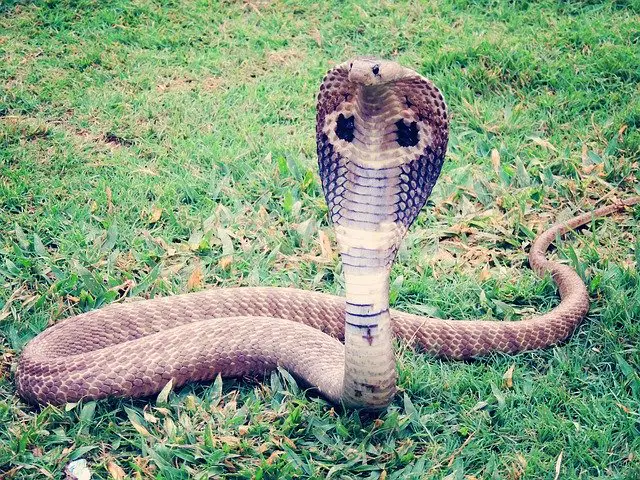
King Cobra Meaning
- King cobra means a venomous snake species that is the largest of all venomous snakes. It is native to South and Southeast Asia.
What Do King Cobras Look Like
- An adult full-grown king cobra has olive green, brown, black or yellow skin.
- They have white or yellowish bands or chevrons on the trunk that extends to the head.
- 15 shields of black or light-brown color cover their head.
- They have a cream color or light-yellow throat and rounded muzzle.
- Juvenile individuals usually have the jet-black color of skin and white or yellow bands on the body.
- King cobras have two fangs of about 0.5 inches in length and 3 to 5 maxillary teeth fixed on the upper jaw.
- They have oval-shaped hoods covered with smooth scales. Between the lowest scales, they have two spots of black color.
- They have a cylindrical tail of yellowish-green color with black markings.
- King cobra is the longest of all venomous snakes and reaches up to 4 meters in length.

Scientific Classification Of King Cobra
- The following is the scientific classification or taxonomy of the king cobra:
| Kingdom | Animalia |
| Phylum | Chordata |
| Subphylum | Vertebrata |
| Class | Reptilia |
| Order | Squamata |
| Suborder | Serpentes |
| Family | Elapidae |
| Subfamily | Elapinae |
| Genus | Ophiophagus |
| Species | Ophiophagus hannah |
How Big Is A King Cobra – King Cobra Size
- The size of adult full-grown king cobras ranges from 10.4 to 13.1 feet (3.18 to 4 meters) in length.
- The body width of an adult full-grown individual at the neck region is up to 1 foot (0.3 meters).
- King cobras show sexual dimorphism and male individuals are larger than females, especially during the breeding season.
- The average length of males is about 3.75 meters (12.3 feet) and weighs up to 10 kg (22 pounds).
- The maximum length of females caught in Karela (India) was 2.75 meters (9.0 feet).
King Cobra Length
- The length of king cobras ranges from 10.4 to 13.1 feet (3.18 to 4 meters).
Biggest King Cobra In The World – World’s Largest King Cobra
- The biggest known king cobra was 19.2 feet (5.85 meters) long.
- The heaviest known individual was caught in Singapore that weighed 12 kg (25 pounds).
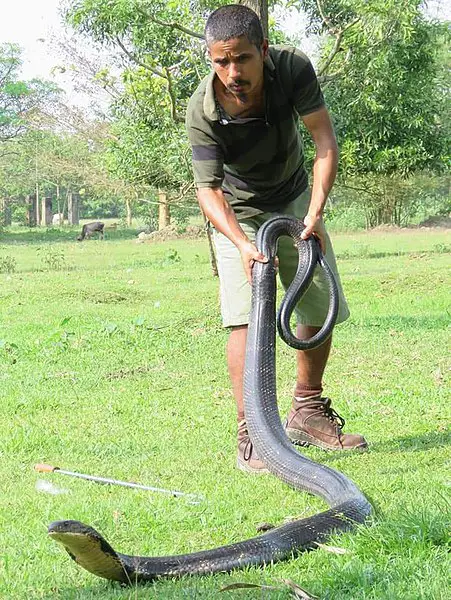
How Fast Is A King Cobra – King Cobra Speed
- It is unknown what is the fastest speed of a king cobra.
How Many Years Does Cobra Live – King Cobra Lifespan
- The average lifespan of king cobras in the wild is 20 years.
Types Of King Cobra – King Cobra Species
- King cobra is the only species or type of its genus.
Indian King Cobra
- King cobras are found throughout the rainforests and plains in India.
- There is no difference between the Indian king cobras and those found in other countries.
Chinese King Cobra
- In China, king cobras are found in the southern regions of the country.
- They have about the same appearance and size as the king cobras found in other countries.
California King Cobra
- King cobras are native to South and Southeast Asia.
- They are not found naturally in California.
- However, they are kept in captivity along with cobras at the San Diego Zoo, California.
King Cobra Philippines
- King cobras are also found in the Philippines.
- They have about the same size, weight, and appearance as the king cobras found in other countries.
Albino King Cobra – White King Cobra
- White king cobras may be albino or leucistic; two genetic disorders that cause white or no coloration of the skin.
- The animals with leucism partially lose the pigmentation and have the pale, white, or patchy color of skin, scales, or feathers but have normal eyes.
- In albinism, the animals lose all pigmentation and have pink or red eyes due to the blood vessels showing through.
- Albino and leucistic king cobras are very rare.
- They face many problems in the wild and often do not survive to adulthood.
- Due to the white color of skin, they can not camouflage to hunt prey and to avoid predators.
- Lack of pigmentation also makes them prone to sunburn and it becomes difficult for them to regulate their body temperature.
King Cobra Head
- King cobras have a small, oval head covered by 15 shields of light brown color with black edges.
- They have a rounded muzzle.
- Their nostrils are located between the two shields.
- They have a pair of large eyes with round pupils and a golden color iris, laterally located on the head.
- The hood of king cobras is oval-shaped and covered by smooth scales of olive green color.
- Between the two lower scales of their hood are two black spots.
- Like other snakes, they have a pair of occipital, parietal, temporal, frontal, prefrontal, and internasal scales.
- When threatened, king cobras make a hood by elongating their ribs towards their neck and expanding the looser skin of their neck outwards.
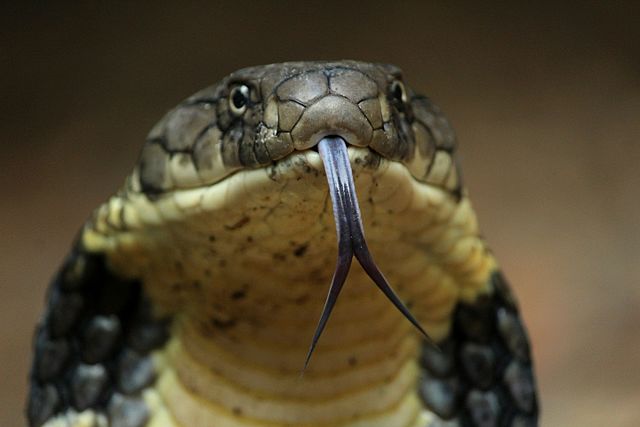
What Do King Cobras Eat – King Cobras Diet
- King cobras are carnivores and eat other snake species and lizards as their primary diet.
- The major snake species they eat include; Indian cobra, pythons, banded kraits, banded wolf snake, rat snake, green whip snake, Blyth’s reticulated snake, and keelback.
- They also prey on hump-nosed pit viper and Malabar pit viper by following their scent trails.
- In case of food scarcity, they also eat small vertebrates, such as lizards and birds.
- In Singapore, a king cobra was observed eating a clouded monitor.
- King cobras do not chew food and swallow it as a whole (sometimes snakes larger than their head). They rely on the strong acids of their stomach to digest food.
- King cobras sometimes constrict their prey by putting pressure on their muscular body. However, this is not common.
- King cobras have a slow metabolic rate. After a big meal, they can survive for many months without food.
King Cobra Zoo Diet
- In captivity, the diet of king cobras mainly consists of rodents.
- At the Smithsonian National Zoo, king cobras are fed with mice and rats.
Cobras Hypnotize Their Prey
- In the wild, cobras are observed fixating on prey with unblinking eyes.
- When hunting, a king cobra sometimes raises one-third of its 18 feet long body off the ground and looks standing as tall as an adult human.
- The prey animals are observed waiting for stationary rather than escaping as the snake approaches to engulf them.
- While birds are observed fluttering in front of the snake rather than flying away to escape.
- Witnesses say that king cobras look like hypnotizing their prey to submission.
- However, scientists say that is not actually what’s happening and provide some theories to explain why some prey animals do not escape after confronting cobras;
- The prey animals may be frozen due to extreme fear.
- The prey animals may stare out of curiosity without realizing the danger they face.
- According to Herps of North Carolina, the fluttering bird in the front of the snake is likely a mother who sacrificed herself in an attempt to divert the snake’s concentration from her nest of babies.
King Cobra Food Chain
The following is the food chain of king cobra:
- Sun is the all-inclusive energy source.
Producers
- In the food chain of the king cobra, Indian weeds, Indian berries, and many other types of grasses are the producers. They take energy from the sun and prepare their food itself through the process of photosynthesis.
Primary consumers
- The primary consumers are the Indian bush rat, the lion-tailed Macaque, the Indian frog, and the China kata.
Secondary consumers
- The secondary consumers are the Bengal monitor, rat snake, and Indian scorpion.
Tertiary consumers
- Tertiary consumers in this food chain are the King Cobra and the Indian grey mongoose.
King Cobra Ecology
- King cobras are mainly found in the rain forests and plains in India, Southern China, and Southeast Asia.
- They play a vital role in their ecosystem by controlling the population of many animal species.
- If the king cobra became extinct, the population of rat snakes and Bengal monitor would quickly extend in number. Their struggle for food would otherwise cause the near extinction of the primary consumers.
- After the near-extinction of primary consumers, the population of rat snakes and Bengal monitor would then fall due to food scarcity.
- In the absence of king cobras, the Indian grey mongoose would also have not enough food to eat.
- So king cobra is a critical part of its ecosystem.
Where Do King Cobras Live – King Cobra Habitat
- King cobras are native to South and Southeast Asia.
- They are mainly found in the rain forests and plains.
- They feel comfortable in a variety of habitats, such as rain forests, high-elevation grasslands, bamboo thickets, mangrove swamps, and rivers.
- Their coloration changes greatly from region to region.
- They usually prefer to live near streams, where the humidity and temperature are relatively constant.
- They spend about one-fourth of their time in bushes or up in the trees.
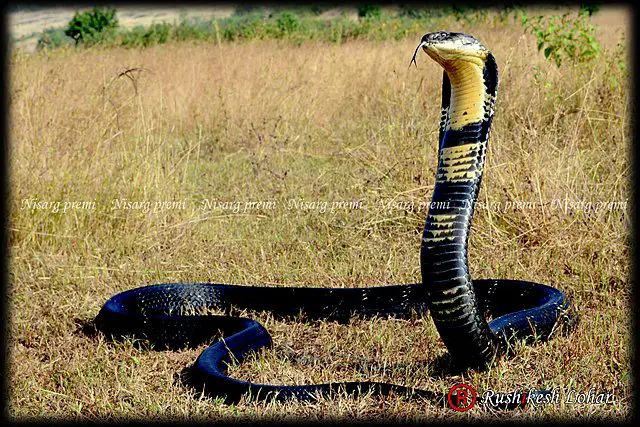
King Cobra Distribution – King Cobra Range
- King cobra has a wide habitat range and distribution in South and Southeast Asia.
- They are found at the altitude of 6,600 feet (2,000 meters) from the Tarai (a lowland region in northern India and southern Nepal) to the Brahmaputra River basin in Bhutan.
- They are found in northeast India, Bangladesh, Myanmar, southern China, Vietnam, Thailand, Laos, Cambodia, Singapore, Malaysia, Indonesia, and the Philippines.
- In northern India, they are found in the Garhwal and Kumaon regions of Uttarakhand and the Shivalik and Terai regions of Uttar Pradesh.
- In northeastern India, king cobras are found in the northern West Bengal, Assam, Sikkim, Arunachal Pradesh, Meghalaya, Nagaland, Mizoram, and Manipur.
- In the Eastern Ghats of India, king cobras are found from Tamilnadu to coastal Odisha, as well as in Bihar and southern West Bengal.
- In the Western Ghats of India, king cobras occur in Karela, Karnataka, Maharashtra, and Gujarat.
- King cobras are also found in the Great Andaman archipelago and Baratang Island of India.
King Cobra Reproduction
- King cobras reproduce through an oviparous (egg-laying) method of reproduction.
- Their breeding season is usually from January to April.
- The female lays an average number of 21 to 40 white leathery eggs in the form of a group known as a clutch.
- King cobra is the only snake species that builds a nest of dry leaves and branches, where the eggs are incubated through the raised temperature of decomposition.
- The female guards the eggs and stays at the top of the nest while the male partner remains close to her.
- Both the partners tend to be extremely aggressive towards the approaching humans during the period of brood care.
- After the incubation of 66 to 105 days, the eggs hatch.
King Cobra Lays Eggs
- Female king cobras lay white lathery eggs.
- The average number of eggs in a group known as the clutch is 21 to 40. However, a clutch size may range from 7 to 43.
- King cobra lays eggs in a nest of dry leaves and branches that is mostly located at the tree base.
King Cobra Life Cycle
- The life cycle of a king cobra starts when a hatchling becomes sexually mature.
- Their mating season is from January to April.
- The females lay a group of eggs known as a clutch that hatches after the incubation of 66 to 105 days.
- The hatchlings mature at the age of 5 to 6 years.
- The king cobras may mate for life.
- King cobras live for about 20 years in the wild.
King Cobra Child – King Cobra Hatchlings
- Child king cobras are known as hatchlings.
- A hatchling has a body length between 14.8 and 23.0 inches (37.5 and 58.5 cm) and weighs from 9 to 38 grams.
- They have bright markings that usually become dim as they mature.
- The hatchlings are nervous and alert and become highly aggressive upon disturbance.
- The hatchling has the same potent venom like that of adult individuals.
- The hatchlings are likely to mature at the age of 5 to 6 years in the wild. However, in the case of insufficient food availability, they may take a longer time to mature.
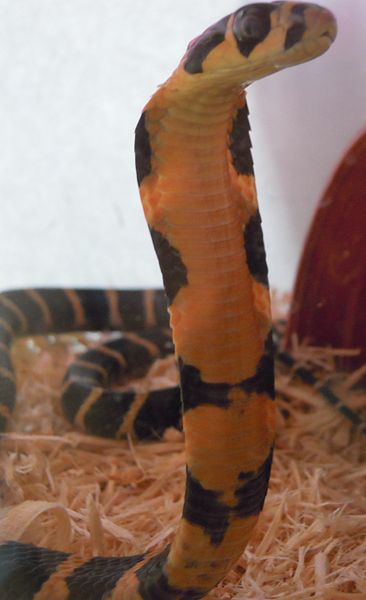
King Cobra Adaptations
- King cobra has many adaptations to survive in their tough environment. Their adaptations are put in two categories;
Structural or Physical Adaptations
Skin color
- The skin color of king cobras is olive green, black, faint brown, or beige.
- Skin color and patterns in their body provide them camouflage in their natural habitat.
Hood
- The hood of king cobras is their ribs that extend out to the looser skin of their neck.
- When they feel threatened, their hood expands out which makes them appear bigger and warns the predators to stay away.
Muscular Body and large body size
- King cobras have an exceptionally large body size of all the snake species. Their large body size makes the other animals and predators frighten and keep them away.
- They have muscular bodies which make them able to move easily while keeping up one-third of their body, as tall as an adult human.
- Their muscular bodies make them excellent climbers, and so they also spend time in trees.
- King cobras can jump 4 to 8 feet high in the air.
- Their muscular bodies also make them good swimmers and they prefer to live near streams and waters.
Venom
- The venom of the king cobra is one of its physical adaptations.
- With their venom, they easily prey on larger animals than their body size.
- King cobras use their deadly venom to fall down an animal as large as an elephant with a single bite.
Fangs and flexible jaws
- King cobras have sharp and long fangs and extremely flexible jaws.
- Their fangs make them able to tear apart their prey. It also helps to push food on the way to its stomach.
- Their flexible jaws allow them to swallow prey, like snakes, as a whole.
Tongue
- The forked tongue of the king cobra detects scent particles in the air and then transfers it to a receptor organ located at the roof of its mouth, known as the Jacobson’s organ.
- It allows them to smell prey and other things from a long distance.
Sense of hearing
- King cobras can not hear the ambient noises of the surrounding.
- However, they are extremely sensitive to earth-born vibrations and can locate prey at a distance of about 100 meters (330 feet).
Behavioral Adaptations
- King cobras exhibit several behavioral adaptations.
- They are considered diurnal and mostly hunt during the day, but are also rarely seen at night.
- It is the only snake species in the world that builds nests where the female lays eggs. Both the partners guard the eggs fiercely.
- King cobras are naturally shy and avoid confrontation. However, they do not hesitate to bite if provoked or feel threatened.
How Do King Cobras Survive In The Wild
- King cobras have many adaptations, which helps them to survive in the wild.
King Cobra Care
- King cobras, especially their hatchlings, require special care.
- They need fresh and clean water daily.
- Adult individuals drink a huge quantity of water after a meal.
- If the water is contaminated or not frequently changed, it would cause the death of some hatchlings due to irreversible dehydration.
- So the king cobras of all ages need special care if someone wants to keep them in captivity.
What Eats King Cobras – King Cobras Predators
- Mongoose is the major natural predator of the king cobra.
- Mongoose can prey and kill king cobras. They also have immunity to its venom. However, they rarely hunt king cobras.
- Human beings are the biggest predators of king cobras. It is hunted for its skin, meat, and use in traditional Chinese medicine.
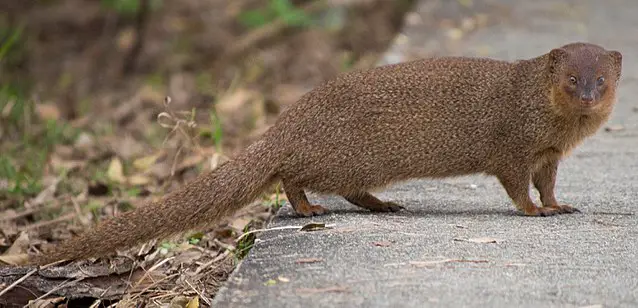
Are King Cobras Endangered
- No, king cobras are not endangered.
- However, they are threatened due to the destruction of habitat and excessive hunting.
King Cobra Conservation Status
- The conservation status of king cobra on the IUCN Red List as Vulnerable.
How Many King Cobras Are Left In The World – King Cobra Population
- The exact number of king cobras left in the world is unknown.
- However, according to the IUCN Red List, their current population trend is decreasing.
- Between 1935 and 2010, their population has declined by 30%.
King Cobra Population 2020
- It is unknown how many king cobras are left in the world in 2020.
Are King Cobras Poisonous – King Cobra Most Venomous Snake
- Yes, cobra is extremely poisonous.
- Among the venomous snake species, its venom is not the most powerful.
- However, it is so deadly that the amount it delivers in a single bite is enough for 20 people to die.
King Cobra Venom
- The venom of king cobra consists of cytotoxins (the toxins that destroy cells) and neurotoxins (toxins destructive to neurons), including three-finger toxins and alpha-neurotoxins.
- Other components in the venom cause cardiotoxicity (damage of the heart muscles).
- A protein in the venom, known as Ohanin, causes hyperalgesia (increased sensitivity to pain) and hypolocomotion (inhibition of locomotory activity) in mammals.
- In one bite, a king cobra can deliver about 420 mg of venom in dry weight.
- Toxins in the venom affect the central nervous system of the victim and cause severe pain, vertigo, drowsiness, blurred vision, and then paralysis.
- In case of serious envenomation, cardiovascular collapse occurs and the victim falls into a coma.
- The victim then dies soon due to respiratory failure.
- The victim takes only 30 minutes to die of serious envenomation.
- Antivenom is used to reverse the progression of symptoms.
How Long Does Cobra Venom Take To Kill
- If someone received a full dose of venom upon the biting of a king cobra, he would take only 30 minutes to die.
What Happens When You Get Bit By A King Cobra
- If someone gets bit by a king cobra and does not receive immediate first aid and treatment, then he/she will die.
- Death will not be easy. The neurotoxic venom will cause the paralysis of muscles around the lungs and disturb the heartbeat.
- The victim then dies of suffocation and cardiac collapse.
Why Are King Cobras Not Cobras
- Despite having the common name “King Cobra”, the king cobra is not a true cobra.
- King cobra is classified in a separate genus “Ophiophagus” rather than keeping it in the “Naja” genus of true cobras.
- Genetic evidence shows that king cobras have a close relationship with the mambas found in sub-Saharan Africa, instead of with the true cobras.
- Physically, many things make a king cobra distinct from true cobras:
- A king cobra has a larger size as compared to true cobras and is the world’s longest snake species.
- The hood of the king cobra is narrow as compared to that of the Naja species.
- The head of a king cobra is larger relative to its body size.
- A king cobra has a pair of elongated and matching occipital scales at the base of its neck, which is absent in true cobras.
- King cobras eat other snake species, including the true cobras and vipers.
- King cobras also show a special behavior of building nests for eggs, which is absent in true cobras.
Austin Stevens King Cobra
- Austin Stevens is an Australian naturalist, wildlife photographer, herpetologist, documentarian, and author.
- He spent 107 days and nights along with the 36 dangerous and most venomous snakes of the world in a glass cage in India.
- He did this as an attempt to attract the public’s attention to the dangerous situation of African gorillas and to generate funds for them.
- By doing this, he set a record in the Guinness World Records, which has not been broken and never been duplicated.
Interesting Facts About King Cobras
- King cobra is the world’s longest venomous snake species, which can reach 18 feet in length.
- Despite its common name, the king cobra is not a cobra species and belongs to a separate genus “Ophiophagus”.
- The venom of the king cobra is potent enough to kill an elephant or 20 people in a single bite.
- King cobras are excellent climbers and spend about one-fourth of their time up in the trees.
- King cobra is naturally a shy snake and draws back when confronted. It becomes aggressive only if threatened or provoked.
- King cobra is the only snake species in the world that builds nests where the female lays eggs.
- King cobras make growling hiss of about 2,500 Hz frequencies.
- Mongoose is the only known natural predator of a king cobra that has immunity for its venom.
- There is a ritual in Myanmar that involves a female charmer (a priestess) and a king cobra. At the end of the ritual, the charmer priestess kisses the snake at the top of its head.
- In the United States, researchers on cobra venom obtained pain relievers, such as Nyloxin (used for the relief of severe pain in arthritis) and Cobroxin (used to block nerve transmission).
